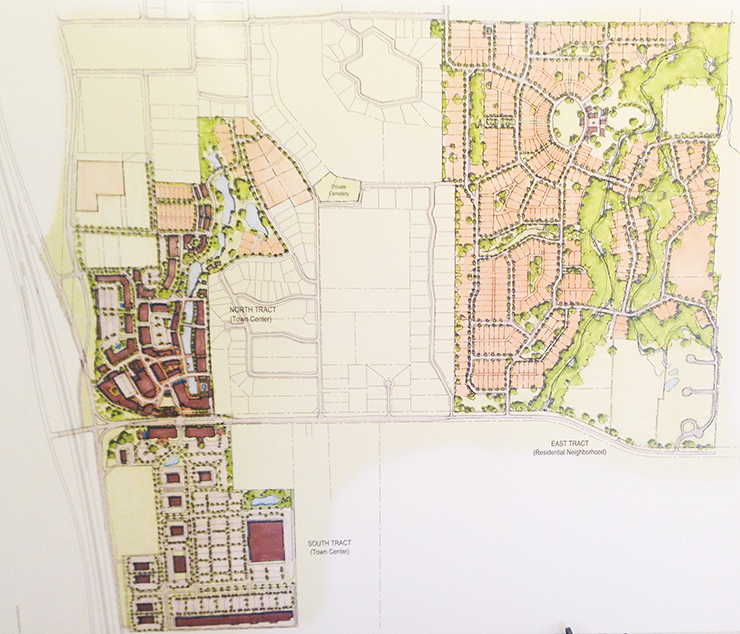By Tim Fleischer Editor-in-Chief
Robert Sulaski will give aldermen an update on Sanctuary development at their 6:30 p.m. Sept. 6 meeting at the Salado municipal building.
While the Village of Salado will be ready to provide sewer service to the property by January 2019, no work has been done on the Sanctuary development of commercial, hotel, entertainment, multi-family and single family construction, other than the demolition of the Wildfire Arena.

In 2015, aldermen and Sanctuary developers signed Master Development Agreement, Conceptual Master Plan, Land Uses Master Plan, Sewer Services Agreement, Annexation agreement and a Chapter 380 Economic Development agreement.
The Land Uses Master Plan outlines the following general use categories and specifications, which can be amended by as much as 20 percent without further approval:
• Commercial (e.g. office, retail, restaurants, etc.): 515,000 heated sq. ft.
• Entertainment Venue: 40,000 heated sq. ft.
• Lodging: 355 rooms.
• Multi-family (multi- story including senior housing and rental): 575 units.
• Mutli-Family (for sale including condos, townhouse and duplexes): 130 units.
• Single Family (for sale): 364 units.
• Parking Garage: 500 spaces
The Master Development Agreement also approves the road design standards identified in the Conceptual Master Plan. It includes roadway connections to the following Village roads: Royal Street, College Hill Drive, Baines Street, Santa Maria Road, San Jose Road, Salado Oaks Drive, Main Street and FM 2268.
The Design Guidelines referred to in the Master Development Agreement states that the Developer will provide design guidelines to the “Village of Salado prior to the first preliminary plat.”
Billy Hanks, owner of the 300+ acres that will become Sanctuary told Saladoans in late 2015 that the architectural design for the Sanctuary will be based on the historic architecture of four European areas: Rosenberg, Germany, Bruges, Belgium, Madrid, Spain and central Portugal.
“It will be utter romance,” he said, “the best of the best in Europe. We sent architects and designers and land planners around Europe to bring back these ideas. We have sketches of door handles, hinges, even the depths of window spaces.”
Hanks said that the property will be developed keeping historic architecture and feel in mind. He pointed out that there will be 14 parks on the property and a walking/hiking/bike trail along a stream running through the property.
At that time, the Sanctuary group had preliminary drawings of a 90-room boutique hotel that borrows designs from the Bruges, as well as the Biltmore Estate in North Carolina.
The hotel, along with a senior center, commercial center and a cultural center, will be built in Phase I of the project, according to Hanks in late 2015.
Streets will have the look and feel of old European cities. “There won’t be curbs and gutters and wide streets like we have in the states,” he said. Instead, they streets will feature cobblestone. “They will be safe to meet the standards needed for fire and police service,” Hanks said.
The Chapter 380 Economic Development agreement outlines 15 years of tax rebates for commercial properties. It states that the owners will receive rebates equal “to the annual Property Tax Receipts actually received by the Village associated with such development (if any) less the amount of Property Tax Receipts in the Base Tax Year for the property associated with such development,” multiplied by 50 percent.
At the time the agreement was signed, then-city manager Kim Foutz said that the tax rebate does not apply to the debt service tax for the sewer plant. Properties in Sanctuary will pay the full debt service tax.
The property taxes will rebated for a period of 15 years “from the recording date of the last Subdivision as defined by the Village of Salado Subdivision Ordinance No. 2009.02 or the 15th anniversary date of the last certificate of occupancy issues for a commercial building, whichever is the last to occur.”
The Chapter 380 agreement also includes Rollback Grants for periodic economic development grants “equal to 100 percent of the Rollback Taxes to offset the portion of the Owner’s cost of development of the Land.” Rollback Taxes are defined in the Chapter 380 agreement as “the tax and/or penalty assessed against the Land, or operation thereof, as the result of the removal of agricultural and/or open space land designation(s) for the Land.”
Additionally, the agreements include verbiage concerning Future Phases in which it states that the Village “shall look favorably in good faith on extending the existing economic incentives” for the future.
Phase Two Entertainment District which will consist of an approximately 1,800 to 2,500 seat additional music venue and multistory parking garage. However, the agreement is not binding on this future development.
The agreements signed by the Mayor Skip Blancett and Billie Hanks, Jr. in late 2015 include a Tourism Marketing Agreement in which 50 percent of the hotel occupancy taxes generated by the Sanctuary will be rebated to the development to promote the property for overnight stays. The Tourism Marketing Agreement shall “continue for a period of 15 calendar years from the Opening Date of the last Venue opened to the public by the Owners.”
The Village annexed the Sanctuary properties in February 2016 and later created Planned Development Districts 2, and 3.
PDD No. 2 is 57.985 +/- acres zoned as PDD-C (Planned Development District Commercial), generally located at the southeast corner of FM 2268 and 1-35 frontage road.
PDD No.3 is 53.922 +/- acres to PDD-MU (Planned Development Mixed Use), generally located at the northeast comer of FM 2268 and I-35 frontage road and 197.265 +/- acres to PDD-MU (Planned Development Mixed Use), generally located at the corner of Salado Oaks Drive and FM 2268, and the 700 block of Royal Street Drive.